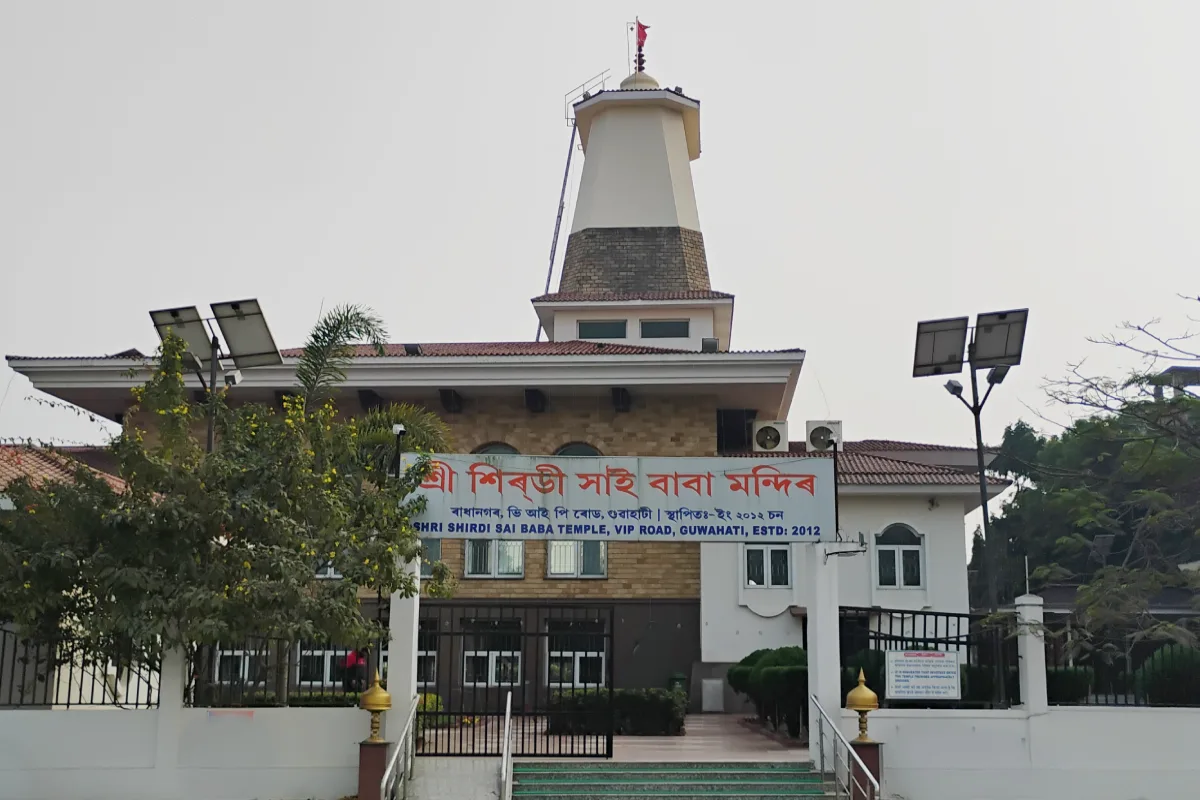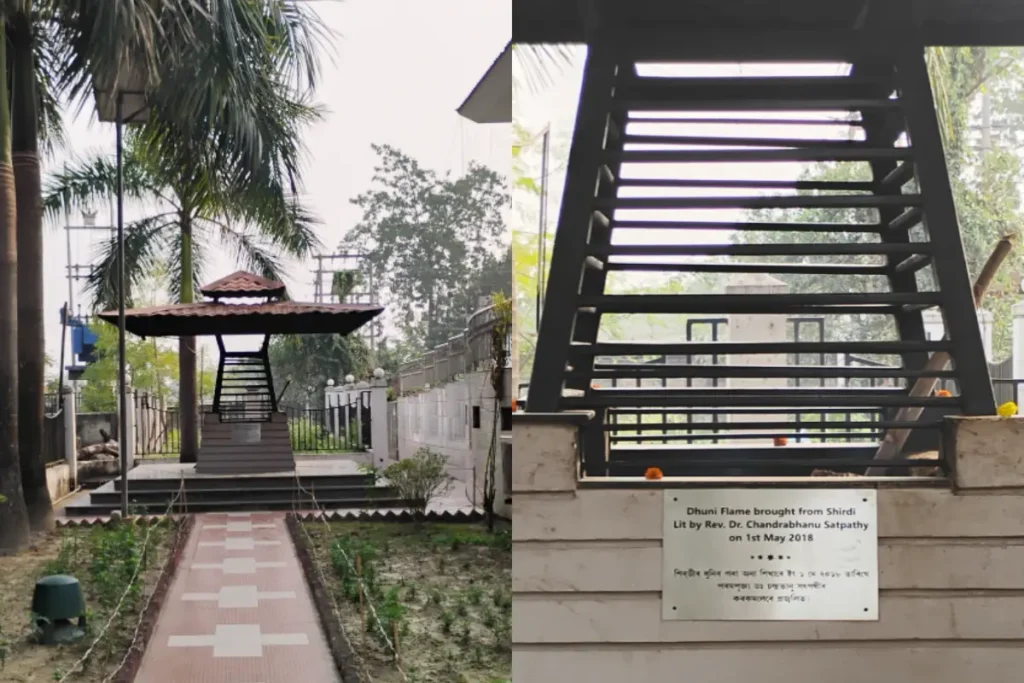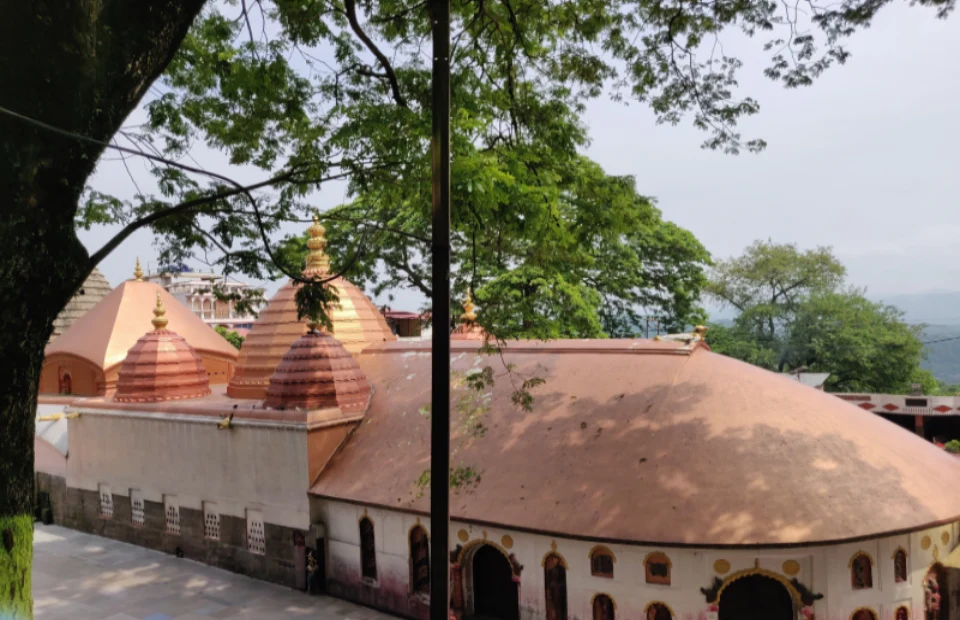Let’s experience peace and devotion at Shirdi Sai Baba Temple in Guwahati, a lesser known sacred pilgrimage site where spirituality and serenity come together.
Rituparna Borgohain
Updated on :
Share this post
The Shirdi Sai Baba Temple in Guwahati is still a less explored place of peace and spirituality. The temple stands in a serene and beautiful environment, attracting hundreds of devotees seeking Sai Baba’s blessings. The atmosphere is always vibrant with incense, lamps, and devotional songs, offering a fresh spiritual experience to every visitor. Sai Baba’s teachings, based on faith, patience, and selflessness, guide everyone toward a pure and peaceful life.

Image: The entrance of the Shri Shirdi Sai Baba Temple in Guwahati
Location of Shirdi Sai Baba Temple
The Shri Shirdi Sai Baba Temple is located at VIP Road, Six Mile, Radha Nagar, Guwahati, Assam. It is easily accessible and situated near notable landmarks such as the famous Basistha Temple and various shopping areas.
Establishment of the Temple
The Shirdi Sai Baba Temple in Guwahati was officially established in 2012, marking a significant addition to the spiritual landscape of Guwahati. The Bhoomi Pujan ceremony was conducted on January 15, 2009, laying the foundation for this sacred site. Since then, the temple has become a beacon of faith and devotion for countless devotees seeking the blessings of Sai Baba.
Spiritual Significance and Other Attractions
Cultural and Religious Hub: The temple hosts religious rituals and festivals, making it a center for spiritual activities. Devotees celebrate Shirdi Sai Baba’s birth anniversary, Ram Navami, and special Thursday prayers with devotion. The temple also observes its establishment day, drawing worshippers for prayers and celebrations. These events create a spiritually enriching atmosphere for all visitors.
Within the Shirdi Sai Baba Temple in Guwahati, there is a special area surrounding the main idol of Sai Baba, where devotees can express their wishes and prayers. This area is enclosed by walls, creating a serene environment for personal reflection and devotion. Devotees often tie threads or notes as symbols of their wishes, seeking the blessings of Sai Baba. This practice adds a unique spiritual element to the temple experience, allowing visitors to connect more deeply with their faith and aspirations.
Dhuni- A Sacred Fire of the Temple: At the Temple, the Dhuni holds great spiritual significance as a sacred fire representing purity and the presence of Sai Baba. It represents the eternal flame of devotion and serves as a focal point for prayers. Devotees gather around the Dhuni, believing that the smoke purifies their intentions as they pray and seek blessings. The flames signify the removal of negativity and the awakening of spiritual consciousness.

The warmth of the fire creates a unique environment, encouraging visitors to connect deeply with their faith. Additionally, the ash from this Dhuni, known as Udi, is used by devotees to mark their foreheads at the Shirdi Sai Baba Temple in Guwahati.
Architectural Beauty: The architecture of the Shirdi Sai Baba Temple in Guwahati showcases a harmonious blend of traditional Indian design and contemporary elements. The temple features a grand entrance that welcomes devotees into its sacred space. The main sanctum houses a beautifully crafted idol of Sai Baba, surrounded by elegant marble flooring and intricate decorative motifs. The vibrant colors and detailed artwork throughout the temple create a warm and inviting atmosphere. Additionally, the spacious courtyard accommodates gatherings and community events, enhancing the temple’s significance as a center of spiritual activity. Overall, the temple’s architecture reflects deep devotion and artistic expression, making it a noteworthy landmark in Guwahati.
Surroundings Beauty: The temple is beautifully surrounded by lush greenery and well-maintained gardens, creating a serene atmosphere for devotees. The temple’s architecture, adorned with intricate carvings and a grand entrance, adds to its charm. Visitors can enjoy the peaceful ambiance enhanced by the fragrance of incense filling the air. The harmonious blend of nature and spirituality makes the temple a truly enchanting place for all who visit.
Relaxation area: The Shirdi Sai Baba Temple in Guwahati is not just a place of prayer but a center of spiritual peace. You can experience deep tranquility here and connect with your faith. The temple’s sacred environment fills you with divine energy and devotion. The Relaxation Area offers you a peaceful space to rest and reflect. All these elements make the temple a significant place of faith and devotion.
About Shirdi Sai Baba
Shirdi Sai Baba was a revered saint known for his teachings on faith, love, and selfless service. He lived in Shirdi, Maharashtra, during the late 19th and early 20th centuries, dedicating his life to guiding people toward spirituality. He emphasized unity among all religions, teaching that God is one. His followers believe he performed miracles, healed the sick, and spread messages of kindness and charity.
Even today, millions of devotees seek his blessings and follow his teachings. His legacy continues to inspire people at temples like the Shirdi Sai Baba Temple in Guwahati, where devotees gather to experience his divine presence.
Aarti Timing at Temple
The Shirdi Sai Baba Temple in Guwahati is well managed by the Shri Shirdi Sai Spiritual and Charitable Trust. The management follows a structured schedule of Aarti and rituals, offering devotees a serene spiritual experience.
- Morning Aarti—7:30 AM,
- Abhishek (Sacred Bath Ritual)—8:00 AM
- Madhyan (Afternoon) Aarti—12:00 PM
- Dhoop Aarti (Evening)—5:45 PM
- Shej Aarti (Night)—8:30 PM
The temple remains closed from 1:30 PM to 3:00 PM. Every Sunday at 4:30 PM, Guru Bhagavat Katha is conducted, allowing devotees to engage in spiritual discourses.
Visiting Time/ Best Time to Visit
The ideal time to visit the temple is early morning or evening, when the environment is peaceful and perfect for prayers. Thursdays are considered especially auspicious, attracting a larger number of devotees. Festivals like Shirdi Sai Baba’s birth anniversary and Ram Navami offer a spiritually enriching experience. The winter months (October to March) provide pleasant weather, making the visit more comfortable.
How to Reach
The Shirdi Sai Baba Temple in Guwahati is easily accessible by various modes of transport, making it convenient for visitors. You can take a taxi, cab, or city bus from any part of Guwahati. Shared auto-rickshaws are also available.
The nearest railway station is Guwahati Railway Station, about 9 km away. From there, you can hire a cab or take a bus.
The nearest airport is Lokpriya Gopinath Bordoloi International Airport, about 34 km away. Taxis and app-based cabs are available for direct travel to the Shirdi Sai Baba Temple in Guwahati.
Bottomline
Shirdi Sai Baba Temple in Guwahati, stands as a beacon of faith, devotion, and spiritual peace. Its calm environment, sacred rituals, and architectural beauty make it a must-visit tourist destination for devotees and travelers alike. Whether you seek blessings, meditation, or a moment of tranquility, this temple offers a truly divine experience.
What time is Aarti in Sai Baba Mandir Guwahati?
The Aarti timings at Shirdi Sai Baba Temple in Guwahati, are as follows:
Morning Aarti: 7:30 AM
Abhishek (Sacred Bath Ritual): 8:00 AM
Madhyan (Afternoon) Aarti: 12:00 PM
Dhoop Aarti (Evening): 5:45 PM
Shej Aarti (Night): 8:30 PM
Why is Shirdi Sai Baba Temple famous?
Shirdi Sai Baba Temple is famous for its spiritual legacy and the teachings of Sai Baba, who emphasized faith, love, and selfless service. Devotees believe in his miracles and blessings, making it a popular pilgrimage site. The temple’s beautiful architecture, regular Aarti ceremonies, and vibrant community engagement further enhance its significance as a place of devotion and tranquility.
Where is Shirdi Sai Baba buried?
Shirdi Sai Baba is buried in Shirdi, Maharashtra, India. His Samadhi, located in the Sai Baba Temple complex, is a significant pilgrimage site where devotees come to pay their respects and seek blessings.
What is the real name of Sai Baba?
The real name of Sai Baba is believed to be Sathya Sai Baba, though he is commonly known simply as Sai Baba. His exact birth name and details remain unclear, as he did not disclose them during his lifetime. He is often referred to as “Sai Baba of Shirdi” to distinguish him from other figures with similar names.



